Welcome!
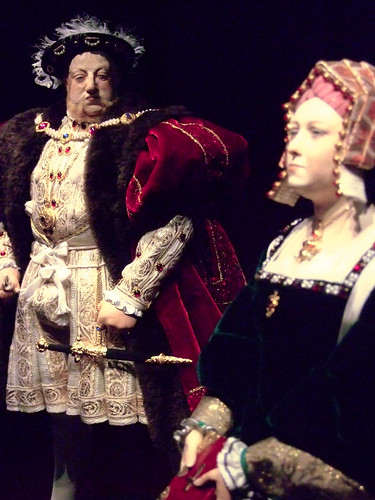 | Henry VIII and Katherine of Aragon by George Stuart. |
Tuesday, May 15, 2007
Doll Artist Valerie Clausen's Elizabeth I
Doll artist Valerie Clausen of Rhiannon's Dolls created this lavishly adorned portrait of Elizabeth I with a Yield House head, arms, and legs. The ornate costume is her own design based on her research of Elizabeth's famous wardrobe.
"However remarkable for the rich display of jewels was the court of Henry VIII, that of ELIZABETH, who inherited her royal father's passion for these precious ornaments, was still more extravagant. In her youth she had entertained, or more probably affected, a distaste for jewellery. "The king, her father," says Dr. Aylmer, "left her rich clothes and jewels, and I know it to be true that in seven years after his death, she never, in all that time, looked upon that rich attire and precious jewels but once, and that against her will, and that there never came gold or stone in her head, till her sister forced her to lay off her former soberness, and bear her company in her glittering gayness, and then she so wore that all men might see that her body carried that which her heart misliked."
This abnegation of vanity and ostentation was, however, whether feigned or not, but of short duration, for she soon outshone every sovereign in Christendom by the profusion and rarity of the jewels with which she was literally covered. Bacon gives some reason for this at the risk of his gallantry, for the court adulations to the last were on her grace and "fair" countenance. "She imagined," says Bacon, "that the people who are much influenced by externals would be diverted by the glitter of her jewels from noticing the decay of her personal attractions." If such were the queen's thoughts as age wore upon her, they are but the same feminine notions that generally prevail throughout time, in most countries...No Queen of England has ever been represented with such a blaze of jewels as Elizabeth. Horace Walpole, speaking of her portraits, says:--"There is not one that can be called beautiful. The profusion of ornaments with which they are loaded are marks of her continual fondness for dress, while they entirely exclude all grace, and leave no more room for a painter's genius than if he had been employed to copy an Indian idol, totally composed of hands and necklaces. A pale Roman nose, a head of hair loaded with crowns and powdered with diamonds, a vast ruff, a vaster fardingale, and a bushel of pearls, are features by which everybody knows at once the picture of Elizabeth."
Elizabeth seems to have had a passion for pearls. The now faded waxwork effigy preserved in West-minster Abbey (and which lay on her coffin, arrayed in royal robes, at her funeral, and caused, as Stowe states, "such a general sighing, groaning, and weeping, as the like hath not been seen or known in the memory of man") exhibits large, round, Roman pearls in the stomacher; a carcanet of large round pearls, etc., about her throat; her neck ornamented with long strings of pearls; her high-heeled shoe-bows having in the centre large pearl medallions. Her earrings are circular pearl and ruby medallions, with large pear-shaped pearl pendants. This, of course, represents her as she dressed towards the close of her life. In the Tollemache collection at Ham House is a miniature of her, however, when about twenty, which shows the same taste as existing at that age. She is there depicted in a black dress, trimmed with a double row of pearls. Her point-lace ruffles are looped with pearls, etc. Her head-dress is decorated in front with a jewel set with pearls, from which three pear-shaped pearls depend. And, finally, she has large pearl-tassel earrings." - JJKent, Inc.
"However remarkable for the rich display of jewels was the court of Henry VIII, that of ELIZABETH, who inherited her royal father's passion for these precious ornaments, was still more extravagant. In her youth she had entertained, or more probably affected, a distaste for jewellery. "The king, her father," says Dr. Aylmer, "left her rich clothes and jewels, and I know it to be true that in seven years after his death, she never, in all that time, looked upon that rich attire and precious jewels but once, and that against her will, and that there never came gold or stone in her head, till her sister forced her to lay off her former soberness, and bear her company in her glittering gayness, and then she so wore that all men might see that her body carried that which her heart misliked."
This abnegation of vanity and ostentation was, however, whether feigned or not, but of short duration, for she soon outshone every sovereign in Christendom by the profusion and rarity of the jewels with which she was literally covered. Bacon gives some reason for this at the risk of his gallantry, for the court adulations to the last were on her grace and "fair" countenance. "She imagined," says Bacon, "that the people who are much influenced by externals would be diverted by the glitter of her jewels from noticing the decay of her personal attractions." If such were the queen's thoughts as age wore upon her, they are but the same feminine notions that generally prevail throughout time, in most countries...No Queen of England has ever been represented with such a blaze of jewels as Elizabeth. Horace Walpole, speaking of her portraits, says:--"There is not one that can be called beautiful. The profusion of ornaments with which they are loaded are marks of her continual fondness for dress, while they entirely exclude all grace, and leave no more room for a painter's genius than if he had been employed to copy an Indian idol, totally composed of hands and necklaces. A pale Roman nose, a head of hair loaded with crowns and powdered with diamonds, a vast ruff, a vaster fardingale, and a bushel of pearls, are features by which everybody knows at once the picture of Elizabeth."
Elizabeth seems to have had a passion for pearls. The now faded waxwork effigy preserved in West-minster Abbey (and which lay on her coffin, arrayed in royal robes, at her funeral, and caused, as Stowe states, "such a general sighing, groaning, and weeping, as the like hath not been seen or known in the memory of man") exhibits large, round, Roman pearls in the stomacher; a carcanet of large round pearls, etc., about her throat; her neck ornamented with long strings of pearls; her high-heeled shoe-bows having in the centre large pearl medallions. Her earrings are circular pearl and ruby medallions, with large pear-shaped pearl pendants. This, of course, represents her as she dressed towards the close of her life. In the Tollemache collection at Ham House is a miniature of her, however, when about twenty, which shows the same taste as existing at that age. She is there depicted in a black dress, trimmed with a double row of pearls. Her point-lace ruffles are looped with pearls, etc. Her head-dress is decorated in front with a jewel set with pearls, from which three pear-shaped pearls depend. And, finally, she has large pearl-tassel earrings." - JJKent, Inc.
Subscribe to:
Post Comments (Atom)


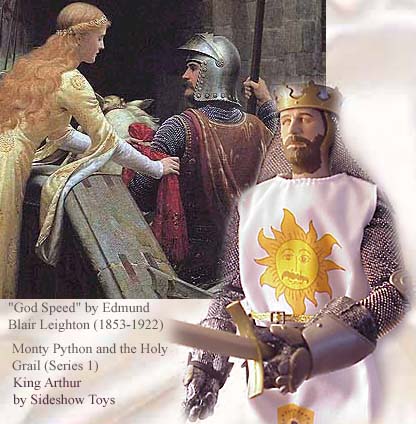
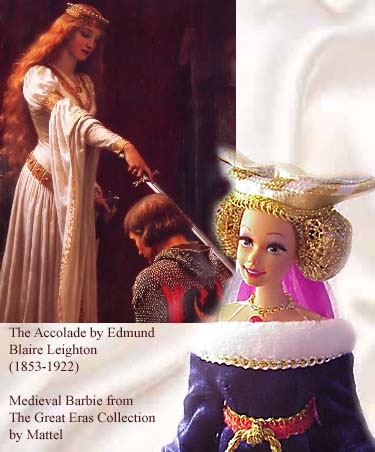
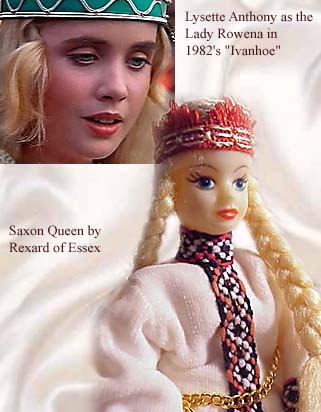
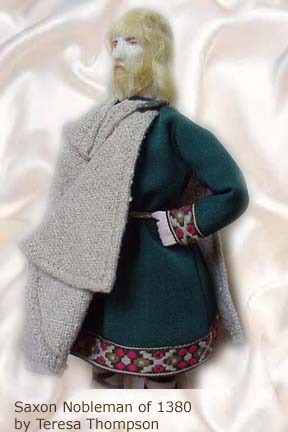 ose worn by men. Wealthy noblewomen might have broad borders of embroidery or braid at the cuffs and hem of these dresses, and in some cases another broad band running from the neck to the hem at centre front. In the case of extremely wealthy women the entire tunic may have been of patterned cloth or covered in embroidery. This tunic was cut very wide, and was probably based on the tunica colobium or tunica dalmatica of late Roman and Byzantine fashion. In England this garment was referred to as a cyrtel, although the Latin loan word tunica was borrowed into English as tunece."
ose worn by men. Wealthy noblewomen might have broad borders of embroidery or braid at the cuffs and hem of these dresses, and in some cases another broad band running from the neck to the hem at centre front. In the case of extremely wealthy women the entire tunic may have been of patterned cloth or covered in embroidery. This tunic was cut very wide, and was probably based on the tunica colobium or tunica dalmatica of late Roman and Byzantine fashion. In England this garment was referred to as a cyrtel, although the Latin loan word tunica was borrowed into English as tunece."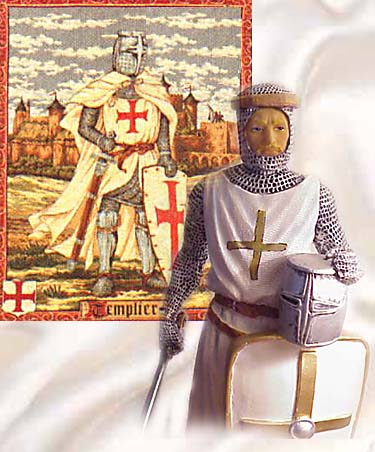 ms, but generally had a long, wide, straight, double-edged blade with a simple cross-guard (or "cruciform" hilt). The typical form was a single hand weapon used for hacking, shearing cuts and also for limited thrusting which evolved from the Celtic and Germanic swords of late Antiquity. Over time, the sword became more tapered and rigid, to facilitate thrusting, and began to add a series of protective rings to the hilt, to defend the fingers and hand. This was the birth of the "cut and thrust" or "sidesword."
ms, but generally had a long, wide, straight, double-edged blade with a simple cross-guard (or "cruciform" hilt). The typical form was a single hand weapon used for hacking, shearing cuts and also for limited thrusting which evolved from the Celtic and Germanic swords of late Antiquity. Over time, the sword became more tapered and rigid, to facilitate thrusting, and began to add a series of protective rings to the hilt, to defend the fingers and hand. This was the birth of the "cut and thrust" or "sidesword."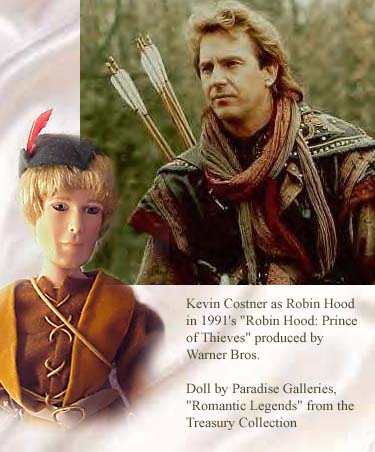 Another popular figure from the Middle Ages is
Another popular figure from the Middle Ages is 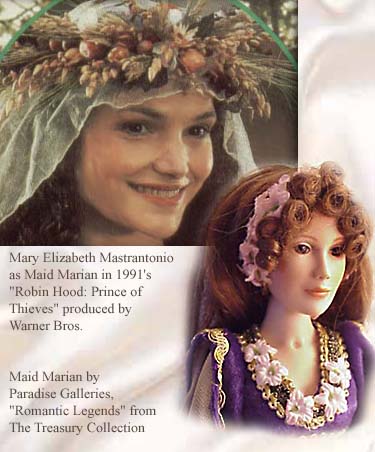 n.
n.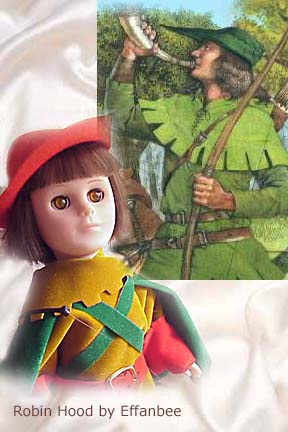 John, disguised as Reynolde Grenlefe, greets the sheriff who is hunting in the forest and "knelyd hym beforne" (line 729). When Little John tells the sheriff that he has just seen "a ryght fayre harte" (line 738) and a herd of deer, he foolishly asks to be taken to the spot where Robin, "the mayster-herte" (line 753), awaits him. After dining with the outlaw band, the sheriff is stripped of his clothing and forced to sleep on the ground. Begging to be released the next morning, he swears an oath that he will not harm Robin or his men in the future. Upon being released, he, humiliated but unharmed, returns to Nottingham where he
John, disguised as Reynolde Grenlefe, greets the sheriff who is hunting in the forest and "knelyd hym beforne" (line 729). When Little John tells the sheriff that he has just seen "a ryght fayre harte" (line 738) and a herd of deer, he foolishly asks to be taken to the spot where Robin, "the mayster-herte" (line 753), awaits him. After dining with the outlaw band, the sheriff is stripped of his clothing and forced to sleep on the ground. Begging to be released the next morning, he swears an oath that he will not harm Robin or his men in the future. Upon being released, he, humiliated but unharmed, returns to Nottingham where he 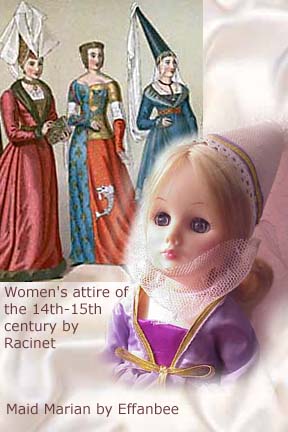 breaks his oath by plotting to capture Robin at the archery tournament."
breaks his oath by plotting to capture Robin at the archery tournament."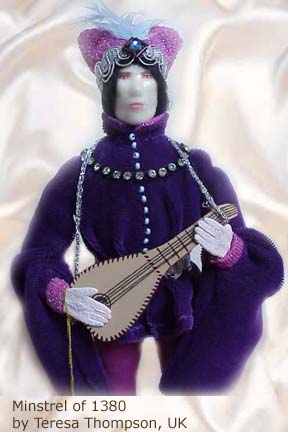 Wandering bards and minstrels also made their appearance in the Middle Ages. The first troubador poet was the grandfather of Eleanor of Aquitaine. Poets often recited tales of courtly love where gallant knights fought bravely to impress a lady that was unattainable because she was already married or betrothed.
Wandering bards and minstrels also made their appearance in the Middle Ages. The first troubador poet was the grandfather of Eleanor of Aquitaine. Poets often recited tales of courtly love where gallant knights fought bravely to impress a lady that was unattainable because she was already married or betrothed. 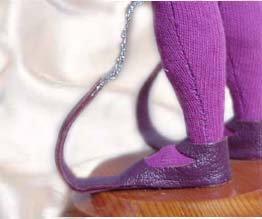
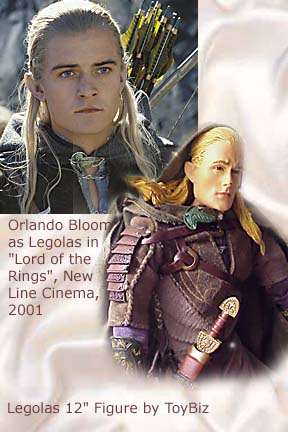 Actually, one of the most realistic costume I have found on a doll -- or uuhumm - "action figure", graces a character from a parallel period, Middle Earth instead of the Middle Ages. The intricately detailed clothing for ToyBiz's 12 inch figure of Legolas from "Lord of the Rings: The Fellowship of the Ring" is exceptional. In the film, Legolas' archery skills certainly looked like they equalled those of Robin Hood. I do wish the figure would have had rooted hair, however. His long, pale blonde hair was one of his most attractive features. I guess "guys" would have thought it made the piece too much like a doll instead of the more masculine "action figure".
Actually, one of the most realistic costume I have found on a doll -- or uuhumm - "action figure", graces a character from a parallel period, Middle Earth instead of the Middle Ages. The intricately detailed clothing for ToyBiz's 12 inch figure of Legolas from "Lord of the Rings: The Fellowship of the Ring" is exceptional. In the film, Legolas' archery skills certainly looked like they equalled those of Robin Hood. I do wish the figure would have had rooted hair, however. His long, pale blonde hair was one of his most attractive features. I guess "guys" would have thought it made the piece too much like a doll instead of the more masculine "action figure".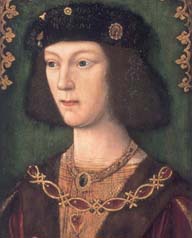
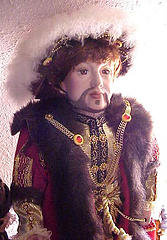
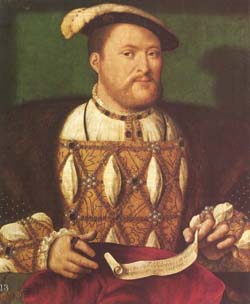 to the
actual women in Henry's life. They are beautiful however and
the costumes are lavishly adorned. I was able to purchase Henry
for
less than $30 although I've seen this doll sell for almost $50.
I purchased all six wives for only $22 each.
to the
actual women in Henry's life. They are beautiful however and
the costumes are lavishly adorned. I was able to purchase Henry
for
less than $30 although I've seen this doll sell for almost $50.
I purchased all six wives for only $22 each.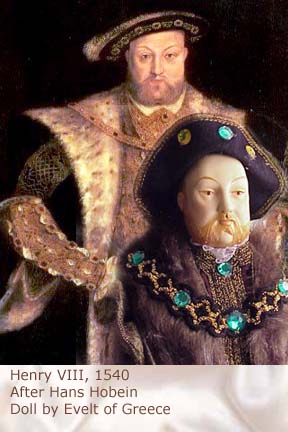 a daughter, Elizabeth.
a daughter, Elizabeth.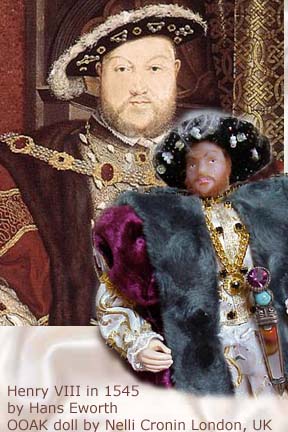 Ebay has opened up a whole world to doll collectors. I was the
successful bidder for a wonderfully detailed one-of-a-kind (OOAK)
Elizabeth I doll created by Nelli Cronin and she mentioned she
also had made a Henry VIII and all of his wives that I readily agreed
to buy as well. Nelli is originally from St. Petersburg, Russia
and is now married to an Englishman and lives in London. Her
finely
detailed Henry VIII is about 8" tall and is adorned with a
real human hair beard. Nelli visits Madame Toussaud's Wax Museum
and uses the wax figures there as models for some of her dolls.
Ebay has opened up a whole world to doll collectors. I was the
successful bidder for a wonderfully detailed one-of-a-kind (OOAK)
Elizabeth I doll created by Nelli Cronin and she mentioned she
also had made a Henry VIII and all of his wives that I readily agreed
to buy as well. Nelli is originally from St. Petersburg, Russia
and is now married to an Englishman and lives in London. Her
finely
detailed Henry VIII is about 8" tall and is adorned with a
real human hair beard. Nelli visits Madame Toussaud's Wax Museum
and uses the wax figures there as models for some of her dolls.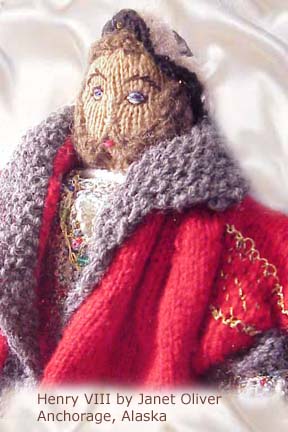

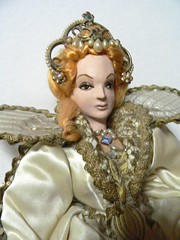 With
all this attention throughout history, it is not surprising that I found
so many different reincarnations of Elizabeth
in the doll world. Probably my most rare Queen Elizabeth doll is a portrait
doll by Ilse Ottenberg. Ilse and her German husband, Richard, were interned
as enemy aliens on the Isle of Man at the outbreak of World War II. To
occupy their time there, the Ottenbergs began making toys
With
all this attention throughout history, it is not surprising that I found
so many different reincarnations of Elizabeth
in the doll world. Probably my most rare Queen Elizabeth doll is a portrait
doll by Ilse Ottenberg. Ilse and her German husband, Richard, were interned
as enemy aliens on the Isle of Man at the outbreak of World War II. To
occupy their time there, the Ottenbergs began making toys 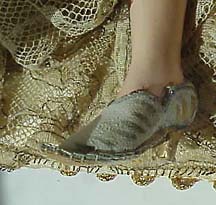 and soon involved
other internees in their work. After the war, the Ottenbergs turned toy
making into their primary livelihood. At the time of Queen Elizabeth
II's
coronation, Ilse submitted a commemorative doll to Buckingham Palace
for the Queen's approval for a franchise of dolls depicting the Royals
and
was one of only two dollmakers who were granted the license. Ottenberg's
dolls are highly detailed. Even the heeled shoes Elizabeth I wears are
carefully hand stitched.
and soon involved
other internees in their work. After the war, the Ottenbergs turned toy
making into their primary livelihood. At the time of Queen Elizabeth
II's
coronation, Ilse submitted a commemorative doll to Buckingham Palace
for the Queen's approval for a franchise of dolls depicting the Royals
and
was one of only two dollmakers who were granted the license. Ottenberg's
dolls are highly detailed. Even the heeled shoes Elizabeth I wears are
carefully hand stitched. 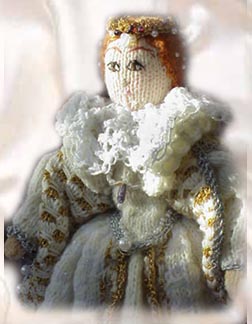 Ottenberg
dolls have been displayed at a number of British Embassies throughout
the world. I feel very fortunate to have obtained one of these dolls on
Ebay for a price of only $80. I continue to search for them (especially
her Cleopatra or Nefertiti dolls).
Ottenberg
dolls have been displayed at a number of British Embassies throughout
the world. I feel very fortunate to have obtained one of these dolls on
Ebay for a price of only $80. I continue to search for them (especially
her Cleopatra or Nefertiti dolls). 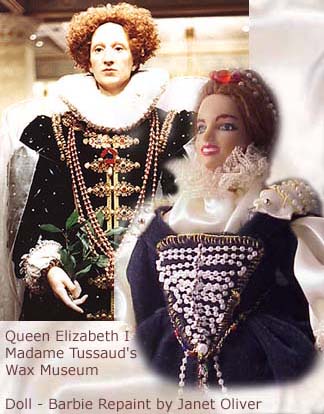 Janet's
Elizabeth Barbie is lavishly decorated with pearls, a trademark of the
this warrior queen. Sir Roy Strong in his book "
Janet's
Elizabeth Barbie is lavishly decorated with pearls, a trademark of the
this warrior queen. Sir Roy Strong in his book "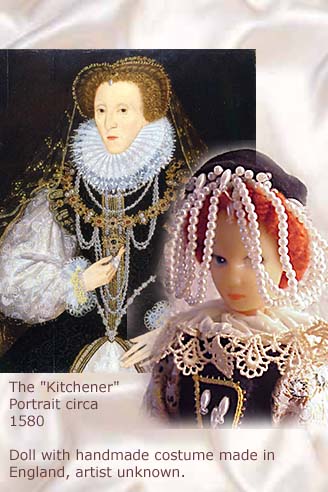
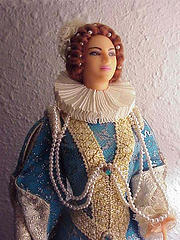 have
the broad smile of one of Marin's dancers and their hands are usually
in the same expressive pose. However, this rendition of Elizabeth draped
in her trademark pearls was more subdued although the queen would have
approved of the hands. Sir Roy Strong observes, "The Queen was particular
proud of her hands and contemporary accounts describe her making much
of taking her gloves off and often she is posed in portraits with her
hands gesturing or resting in front of her chest."
have
the broad smile of one of Marin's dancers and their hands are usually
in the same expressive pose. However, this rendition of Elizabeth draped
in her trademark pearls was more subdued although the queen would have
approved of the hands. Sir Roy Strong observes, "The Queen was particular
proud of her hands and contemporary accounts describe her making much
of taking her gloves off and often she is posed in portraits with her
hands gesturing or resting in front of her chest." 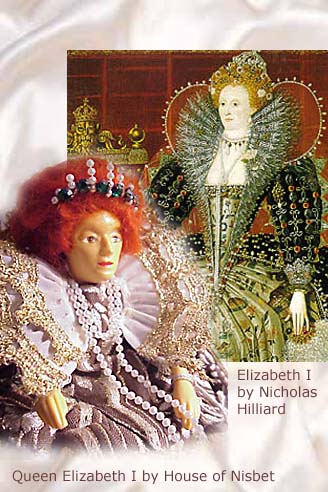 wonder
if she would have approved? Strong writes, "Her policing and concern
over her image was reflected in the Privy Council's order in 1596 to destroy
all portraits of her which were to her 'great offence'. Sir Walter Raleigh
in The History of the World of 1687 describes the works of 'common Painters'
being thrown in the fire. As a result we are justify with a smaller number
of iconic portraits; interesting because of their fine quality and because
they survived the Queen's rigorous editing. We are presented with images
of the Queen fashioned in the way she wished to be presented and make
her unmistakable."
wonder
if she would have approved? Strong writes, "Her policing and concern
over her image was reflected in the Privy Council's order in 1596 to destroy
all portraits of her which were to her 'great offence'. Sir Walter Raleigh
in The History of the World of 1687 describes the works of 'common Painters'
being thrown in the fire. As a result we are justify with a smaller number
of iconic portraits; interesting because of their fine quality and because
they survived the Queen's rigorous editing. We are presented with images
of the Queen fashioned in the way she wished to be presented and make
her unmistakable."
No comments:
Post a Comment